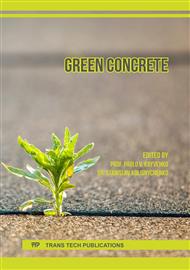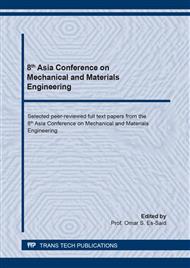p.3
p.9
p.15
p.25
p.30
p.36
p.45
p.51
Embedding Bio-Filler Materials to Enhance Physical-Mechanical-Thermal Properties of Concrete
Abstract:
At present, waste generation is fast-growing around the world due to the increasing of population. Therefore, recycling end-of life materials for sustainable and cleaner production is becoming a major target worldwide. The recycling waste materials is trend toward for many industries to reduce both the consumption of natural resources and the cost of products while protecting the environment from the harmful effects of waste materials. Adding water hyacinth fiber, banana fiber and eggshell powder can increase physical-mechanical-thermal properties of concrete. Concrete with/without adding 0, 0.02 and 0.05 wt% bio-filler via hydration reaction affects to good physical-mechanical-thermal properties. Especially adding 0.05 wt% eggshell powder into concrete has the highest compressive strength (22.08 ± 0.66 MPa) and lowest water absorption (1.62 ± 0.16 %) better than those of concrete without adding bio-filler. Furthermore, adding 0.05 wt% water hyacinth fiber affects to obtain the highest tensile strength equal to 187.63 ± 28.45 MPa. The obtained concrete added bio-filler samples have potential to be used as a good insulation material and building material due to low density, low water absorption, low price, good mechanical and thermal insulation.
Info:
Periodical:
Pages:
3-8
Citation:
Online since:
November 2020
Authors:
Keywords:
Price:
Сopyright:
© 2020 Trans Tech Publications Ltd. All Rights Reserved
Share:
Citation:



